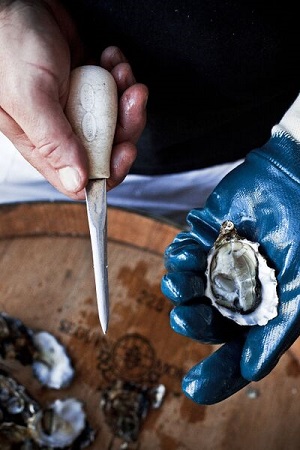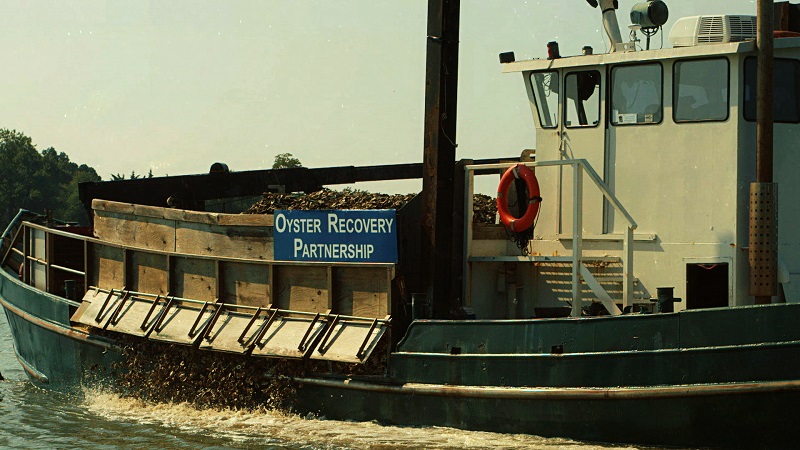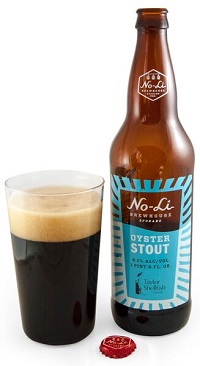Shell Game: The Storied Past and Bountiful Resurgence of Oyster Stouts

Shucking with Hog Island Oyster Co. in Tomales Bay, on the coast of Northern California. (Photo by Ed Anderson)
A few months after the BP oil spill ravaged the Gulf Coast in the spring of 2010, Louisiana’s Abita Brewing Co. announced a homebrew contest. Hundreds of recipes came in from around the country.
Baton Rouge native Kerry Dale Yoes, who had been homebrewing for eight years, looked to his beloved-now-ravaged home for inspiration. “After the spill, some of the local oyster producers were going out of business,” Yoes recalls. “I was trying to figure out ways to promote Louisiana ingredients.”
Yoes submitted his recipe for the Louisiana Imperial Oyster Stout, which had notes of caramel and roasted chocolate, and locally shucked oysters that were added directly into the kettle. Lo and behold, it won the contest and was brewed as a limited release in 2012 and 2013. This October 2015, it will be bottled, become a part of Abita’s regular line and renamed Bad Mother Shucker.
“At first, a lot of people think it sounds weird or that it will taste fishy,” says Abita brewmaster Mark Wilson. “But once you taste it, you get these subtle briny and salty notes that enhance the mouthfeel. Plus, it’s great to be able to do something local.”
In fact, Abita is just one of many breweries in the U.S. that have helped spawn the resurgence of oyster stouts. Once just considered a good pairing for the working class, bivalves and dark beer are now being combined in an ever-growing style.
Because of aquaculture—growing shellfish in an oyster farm or hatchery—and the rising popularity of oysters, the unlikely practice of inserting oysters into stouts is popping up all over coastlines—inspiring brewpubs, festivals and even environmental partnerships. But, in true American brewing spirit, there’s not just one right way to create an oyster stout, and experimentation is the name of the game.
“It’s still a niche style, and it’s never going to be the next IPA or anything,” says Gene Muller, founder of Flying Fish Brewing Co. in New Jersey. “But for those of us near the coast, it’s good for the industry, and we’re changing people’s perceptions.”
Oyster 101
Oysters, in general, are odd creatures. They start out as free-swimming larvae that look for something to cement themselves to, and shells are their preferred substrates.
“If you want to impress your friends, you can call an oyster a bivalve mollusk,” says Ryan Croxton, co-owner of Rappahannock Oyster Co. out of Topping, VA. “Its key benefit is to filter out excess nutrients—those that currently cloud our waterways and don’t allow sunlight to nurture grass growth.”
The oyster population was threatened in various regions of the country in the mid-20th century, due to overharvesting and naturally occurring diseases. But aquaculture was developed around the 1970s and has since revived the oyster population.
Basically, baby oysters (or spat) are farmed from seed in temperature-controlled water. As the oysters mature, they are then placed in cages in the water that re-create natural oyster reefs. They grow over several months before being removed, cleaned and distributed throughout the country. All the while, they are doing their part by filtering the water.
“At the most basic level, it means farming aquatic animals in a controlled setting,” Croxton says of aquaculture. “For us, it’s raising them in their natural habitat with no supplemental feeding and practically zero negative impact to the environment. Oyster numbers are now on a meteoric rise.”
This growing availability, of course, has led to increased awareness of the oyster as a food source, even if it still is considered an acquired taste.
“They are a lot like wine,” says Brenna Schlagenhauf of Hog Island Oyster Co. in Tomales Bay on the coast of Northern California. “The flavor is affected by the area they’re grown in. Because they’re filter feeders, differences in salinity, mineral content and types of phytoplankton will result in different flavors.”
For example, Hog Island currently grows four types of oysters: the smoky-sweet Sweetwater, the mineral-flavored Atlantic, the buttery Kumamoto, and high-in-iodine French Hog.
“Like a chardonnay grape tastes different from one region to the next, so too [do] oysters,” Croxton says. “It’s about the clearest expression of its native waters you can find.”
Perfect Pair
Of course, the relationship between oysters and stouts started long before its recent spike in popularity, as historians trace the marriage back to 19th-century England.
“In the early Victorian period, porters and stouts were everyday beers,” wrote Michael Jackson in The Independent in 1995. “And oysters [were] a bar snack as commonplace as peanuts today.”
 In fact, the pairing eventually became so popular that Guinness ran an advertising campaign starting in the 1930s that encouraged the duo, claiming that the popular stout “brings the oysters out of their shells.”
In fact, the pairing eventually became so popular that Guinness ran an advertising campaign starting in the 1930s that encouraged the duo, claiming that the popular stout “brings the oysters out of their shells.”
Brewers and chefs today echo that sentiment from years ago, explaining that pairing the oysters with a dark stout is a no-brainer. “You get the contrast of the roastiness of the stout and the salinity of the oyster,” says Matt Brophy, brewmaster at Flying Dog Brewery in Frederick, MD. “Then you cleanse your palate again with the roasty stout. It just begs to be repeated.”
As far as the shellfish actually being inserted into the beer, according to Jackson, in 1938 London’s Hammerton Brewery was the first to brew a stout using a canned oyster concentrate manufactured in New Zealand, with the thought being it would provide added nourishment, like lactose added to a milk or cream stout.
There was also the idea that oyster shells acted as a natural fining agent to clear beer in the days before filtration.
“Lots of breweries and taverns used shells as filters,” says D.C.-based beer historian Mike Stein, who gives talks on the science and history of brewing at the Smithsonian and DC Brau Brewing Co. “They balanced the beer, made it brighter and fresher.”
Stein cites a likely post-war ad provided by the Washington Historical Society, in which Crown Cork & Seal Co.—a famous manufacturer of food and beverage cans—“suggested that oyster shells broken up and put into the barrel through the bung-hole, would correct the acidity in beer.”
As pale ales became more popular in the mid-20th century, the oyster stout tapered off for decades, but then enjoyed a revival in Great Britain during the ’80s at breweries like Bushy’s and Marston’s. It took a little while longer, however, to get started back in the States.
“I first heard of an oyster stout probably in the early ’90s,” says John Finger, the owner and co-founder of Hog Island Oyster Co., which sells its oysters to six breweries, including Magnolia and HenHouse, for inclusion in their beer. “Back then, it was a bunch of homebrew beer geeks just having fun.”
That was until some larger breweries caught onto the style, researched the history and decided to play around with it on a larger scale.
“Obviously we didn’t come up with the idea of the oyster stout,” says Dave McLean, founder of Magnolia Brewing in San Francisco, which has been making its Oysterhead Stout, a dry stout with slight coffee and salty notes, with Hog Island bivalves since 2000. “They’ve had significance in England and Ireland for a while. But it came out of a pure fascination and love for oysters.”

Dave McLean of Magnolia Brewing. (Photo by Jon Page)
For other coastal areas, it was a matter of tradition.
“Oysters almost went extinct in the Chesapeake Bay 20 years ago,” says Croxton of Rappahannock, which provides product for Flying Dog’s Pearl Necklace Oyster Stout, and has been in this family for four generations. “With aquaculture stepping up and bringing more oysters to the market, the Chesapeake went from nothing to being a market leader inside 15 years. Now it’s a huge phenomenon.”
One brewer was so inspired during the oyster boom that he opened up a brewpub solely dedicated to the style. Billy Klingel says that one day, when he was working at a Lobster Trap restaurant in Asheville, North
Carolina, his general manager came back from a shucking tournament raving about a home-brewed oyster stout.
“I was working at the raw bar and thought that I knew enough to pull that off in order to make my dream of opening my own brewpub possible,” he says. “So I dedicated a year of my life to obsessively brewing oyster stouts.”
In 2008, he founded Oyster House Brewing Co. in Asheville and now flies in fresh oysters from around the country to brew two varieties, the dry Irish stout Moonstone and the Imperial stout Super Moon.
“It’s fun to get people in the door who may not normally try oysters, but are willing to sip the beer and end up loving it,” he says.
Shuck to Stout
With the oyster farm industry thriving, the rest of the beer industry soon followed suit and oyster stouts began debuting all along American coastlines, including Flying Fish and Upright Brewing in 2009, Flying Dog and Hen House Brewing in 2011, Abita and 21st Amendment in 2012—just to name a few.
According to brewers interviewed for this article, the key is emphasizing that the stout pairs well with oysters, but doesn’t taste exactly like them.
“There was a lot of coaxing people to try it with direct marketing at beer fests,” says Shane Goepel, co-founder of HenHouse Brewing in Petaluma, California. “People wondered if it would taste like fish. With ours, there’s just a touch of ocean air brininess on the nose of the beer. We make it to be a bit subtle.”
That flavor, of course, all depends on the brewing process. And it seems like no two breweries are alike when it comes to creating their oyster stouts. Some, like Abita, just use the oyster meats and juices, which it adds to the kettle with salt water to create its imperial oyster stout.
However, most seem to put whole oysters in the kettle and have come up with some innovative tools so the shells don’t interfere with the brewing equipment. For Flying Dog, it’s a stainless steel basket. For Flying Fish and Magnolia, it’s mesh bags.
At HenHouse, it’s a gradual process, in which the sea salt (which is harvested off the Mendocino Coast) goes in at the beginning of the boil, followed by shells halfway through and then finished with a half-pound per barrel of whole oysters to create its Oyster Stout.
Brewmasters can all agree that most of the briny flavor comes from the shellfish’s juice, known as liquor, which gets released once the oyster is cooked a bit and opens up in the whirlpool.
“We’ve got the process down to a well-oiled machine,” says McLean. “We always have an open invite to our restaurant staff to come over and try a few oysters on brew day.”
To be clear, McLean’s staff doesn’t eat the oysters that have come out of the wort at the end of the boil. He learned that the hard way.
“It only took one taste the first time we brewed this beer to realize it wasn’t going to be a delicious all-you-can-eat bounty,” he says. “They are pretty shriveled, chewy and astringent, having been boiled beyond recognition.”
However, he gets enough additional oysters on brew day for restaurant staff to shuck and eat them while they brew, throwing the shells in the kettle as they go, which has become somewhat of a tradition at Magnolia.
The taste and quality of the actual oysters are crucial, as brewers try to get them right from the boat or seafood market, or at worst overnighted, and oystermen provide a hefty product with bold flavor.
“Brewers usually want our Sweetwaters,” says Finger from Hog Island. “It’s a Pacific oyster, with a lot of complexity and full body, which they like since some of the flavor might get lost in the cooking-down process.”
In Flying Dog’s Pearl Necklace Oyster Stout, a dry stout with roasted character, it’s all about Rappahannock’s Olde Salts, which are grown in the Atlantic and have a higher-than-average salinity level. Oyster salinity is measured on a scale of parts per thousand, from 5 to 35 ppt (0.5 percent to 3.5 percent salt by volume) and an Olde Salt clocks in at 30 ppt.
“I’m not a huge stout drinker, but I love Pearl Necklace because it’s so sessionable,” says Croxton. “We talk about wine and champagne pairing all the time with oysters. But nothing pairs better than a beer.”
Beyond the great taste and quirky marketing of oyster stout as a style, a lot of the brewers’ motivations stem from something entirely more important.
“For me, it was a nice way to say our seafood is still safe,” says homebrewer Yoes, who was able visit Abita for the first brew and is excited to see his creation bottled this fall.
“We incorporate a lot of locally harvested products into our beer,” says Abita’s Wilson. “Sometimes it’s strawberry or grapefruit. This one just happens to be locally shucked Louisiana oysters.”
That local pride and sentiment are echoed in breweries throughout the country, including Flying Fish, whose “Exit” series was based off the idea of making a beer to represent every exit of the New Jersey Turnpike. Exit 1, which is right on the Delaware Bay, inspired its Bayshore Oyster Stout, flavored with English chocolate.
“We had been working with the Delaware Bayshore Project on some fundraising stuff when we got the idea,” Muller says. “It’s so great to be able to use a fresh, local product that hasn’t been hacked up or sitting around. I pick them up right off the boat myself.”

A portion of the proceeds from Flying Dog’s Pearl Necklace (brewed with oysters from Rappahannock Oyster Co.) are donated to the Oyster Recovery Partnership, which plants oysters back into the Chesapeake Bay.
The idea of partnering with a nearby environmental organization is something with which Flying Dog is very familiar. Not only does the brewery get its oysters from Virginia purveyor Rappahannock, but also a portion of the stout’s proceeds (and leftover shells) gets donated to the Oyster Recovery Partnership, a nonprofit that plants oysters back into the Chesapeake Bay.
“We toured their hatchery and it was really cool to see how the process works,” says Flying Dog’s Brophy. “Similar to the brewery, they have tanks with water treatments where they grow the spat, or baby oyster. Once they’re a certain size, they’ll drop them in the oyster beds and they grow and multiply. The stats are amazing. They’ve planted literally billions of oysters. Once we saw that, that gave us extra motivation to say, ‘Okay, let’s do this.’”
Inevitably, that message gets passed along to consumers, who may not have had any idea they liked oysters, let alone how important the creatures are to the environment.
“We do an oyster event every year, a part of San Francisco Beer Week,” McLean says. “It’s a celebration of all things oyster, where we have a special food menu and we release the latest batch of Oysterhead Stout. We’ll have our raw oyster selection with five or six choices. We try to mix it up so we’re educating people.”
What Ifs
Among the brewpubs, festivals and partnerships, it seems obvious that the oyster stout is here to stay.
“Every year, I see one or two new ones out there,” says Klingel, citing Nantucket, Massachusetts-based Cisco Brewing’s 5th Bend Oyster Stout, which was released in November 2014. “I think it’s just exciting. You get stuck doing your same IPA and pale ales every day. An oyster stout brings something new to the brewery.”
The style also has that alluring element of surprise, and as beer drinkers get more sophisticated and adventurous, the demand for out-of-the-ordinary beers only grows.
“Once people realize how good it is, they fall in love with the style,” says Goepel from HenHouse. “My feeling about the beer industry, especially with smaller ones like us, is variety is key. It’s much more fun to play around and experiment.”
With the advent of seafood farming, the oyster stout can now be produced year-round, but most brewers agree that consumers crave dark beers in the fall months (“No one wants a stout in the humid, Louisiana summer,” explains Wilson)—so it’s usually a seasonal.
The most common style of beer to be brewed with oysters is the stout, but there have been a few exceptions, including Night Shift Brewing’s Harborside gose with oysters and coriander; Daughters of Poseidon, a black IPA brewed by DC Brau with Baxter Brewing Co.; and Earth Bread + Brewery’s Earth Blind Oyster Ale, made with only shells.
In fact, putting oysters into a different style of beer is something that McLean from Magnolia has pondered for a while.
“I think about it a lot,” he says. “There’s a healthy argument to be made for really what is the best beer. People say stout, but you could argue for a crisp pilsner or a moderately hoppy pale ale. Now that we know what we’re getting out of the oyster, it’s a pretty subtle set of flavors, and a stout is not so subtle. That begs the question, what would those characteristics taste like in a cleaner beer? I’m sure at some point, we will get to it. There are always the ‘what ifs.’ ”
Put a bit more simply, Klingel from Asheville says, “This style is the best example of trial and error. Maybe use a whole ton of oysters. Maybe only a few. Maybe some with shells, some without. Everything is an experiment.”

Marston's Brewery Oyster Stout
ABV: 4.5%Tasting Notes: Toward the brown shade of black with a thick tan head. The nose is all malt with hints of chocolate, caramel and dark brown sugar. The medium mouthfeel is complemented by sedate carbonation. The flavor avoids the stout espresso bite, settling in with some chocolate chip cookie dough notes and a touch of brine in the finish. A study in malt showing off complexity without becoming heavy.—Daniel Bradford

Flying Dog Pearl Necklace
ABV: 5.5%Tasting Notes: If one didn’t know this beer used oysters, it might not necessarily be apparent from that first sip. That’s probably a good thing. The oysters show through most in the aromatics: a briny, almost peaty aspect that ascends above a firm backdrop of bitter chocolate, roasted malts and a secondary cola note. In the mouth, that salinity is of a more similar volume, fitting in as a salty counterpoint, almost a slickness, to the dark malts and milk chocolate. This is rich, generous, layered and worth spending some time with.—Ken Weaver

No-Li Brewhouse Oyster Stout
ABV: 6.1%Tasting Notes: A collaboration with Taylor Shellfish Farms, which sources Taylor Totten Inlet Pacific oysters from Washington’s South Puget Sound. A highly respectable stout with a quiet mollusk influence. Pours deep dark chocolate with cola-colored edges, capped by a beige head. The brine is on the periphery of the aromatics, with baking chocolate and roasted malts underpinned by notes approximating caramel, even cinnamon. Much more hop forward and oyster subtle than other examples of the style, with firm pine and a soft brush of fruity alcohol. The pine and citrus serve as an edge more than the roast, with cola and red fruitiness in abundance. A pleasantly bitter end.—Ken Weaver

Porterhouse Brewing Oyster Stout
ABV: 4.6%Tasting Notes: This pours a thick midnight-black color, while around the edges are brown highlights that suggest the presence of that special malt that made porters famous. The aroma combines the espresso stout notes with a bit of toffee. The flavor brings together three elements: the grist-y astringency of the dark malts, that briny flavor of oysters and piney and spruce notes from the hops. Combined, they make a surprisingly complicated, exciting profile. While obvious, roasted oysters would be an excellent accompaniment.—Daniel Bradford
Jess Mayhugh
Jess Mayhugh is the digital editor of Baltimore magazine, where she covers drinks and sports. Her work has also appeared in Thrillist, Serious Eats and BeerAdvocate. She prefers her beers sour and will challenge anyone to name a more beautiful ballpark than Camden Yards.

Oysters with beer originate in my view solely because crushed oyster shell was once added to beer to ward against sourness. Many 19th century sources explain this, here is John Forsythe from 1834: https://books.google.ca/books?id=RSdhAAAAcAAJ&pg=PA195&dq=oyster+shell+beer+acidity&hl=en&sa=X&ved=0CDsQ6AEwAmoVChMIqJ_73afOxwIVho6SCh0BMA6N#v=onepage&q=oyster%20shell%20beer%20acidity&f=false
See also Booth’s brewing manual from 1829 in which he mordantly explains that the drinker can take his pick between a sourish flavour in beer and one characterized by a peculiar bitter taste formed by the action of lime carbonate in oyster added to the drink. (Oyster shell is mostly lime carbonate). Many other substances were used to this end including marble dust.
In time, the association between oyster and beer in this sense led people to pair them as food and drink, and finally to add oyster meat to the beer. I never felt oyster and beer have a particular affinity – many will disagree, I know – and consider the practice emerged from this old technological, rather than culinary, link between oyster and beer.
The Crown Cork & Seal ad referenced in the article which recalled this old practice of using oyster shell to correct acidity put its finger on it, IMO.
Gary Gillman
“In time, the association between oyster and beer in this sense led people to pair them as food and drink”
No “in time” about it. Whilst North Americans might look to technology as an explanation, Europeans will tend to look to history and geography.
Whitstable has been the centre of oyster production in England for 2000 years, and it sits in the middle of East Kent, which has been the main centre of hop-growing in England since hops came to England in the late Middle Ages. So in one place you had the peasants eating oysters as the cheap food and beer as the cheap drink – there was no artificial “pairing them as food and drink”, that was just what was available to poor people in that area.
Beer and oysters were the burger and coke of the 18th century – there’s several extant London pubs and restaurants (eg Rules) that started as oysterhouses around that time. London was just down the coast from Whitstable and imported oysters by the million. As the London porter style emerged, that was what was drunk with the typical street/pub food – oysters. So if you’re not quite feeling oysters with stout, I’d suggest you try them with something more like porter than a classic dry stout – one of the main justificitions for oyster stout is that Guinness just isn’t quite right.
You’re right that the idea of putting whole oysters in beer probably originated in people using ground oyster shell to counter acidity, but in the UK the debate continues whether an “oyster stout” contains oysters or is designed for drinking with them. You see both, but FWIW the Kent breweries tend to go without oysters in the brew.
The Whitstable Brewery is part of the Whitstable Oyster Co and brew a pretty decent one – don’t confuse it with the Whitstable Bay Brewery which is Shepherd Neame’s craft label. The Shepherd Neame version isn’t bad, and there’s a better chance you may see it in North America as they have a distribution deal with Sam Adams.